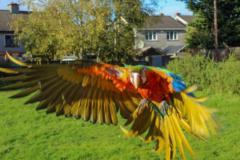Activity
Mon
Wed
Fri
Sun
Jan
Feb
Mar
Apr
May
Jun
Jul
Aug
Sep
Oct
Nov
Dec
What is this?
Less
More
Owned by Steven
Global free-flight parrot community for beginners & pros. Safety Q&As, flight logs, meet-ups, gear, and camaraderie for open-sky adventurers.
Memberships
The AI Advantage
65.7k members • Free
Real Men Real Style Community
13.9k members • Free
Skoolers
180.4k members • Free
6 contributions to The Flight Crew
Welcome to The Flight Crew!
This is the global community for free-flight parrot enthusiasts — whether you’re a beginner just starting out or an experienced flyer logging regular sessions. Here’s how to get started: 1. Introduce yourself: Comment below with: - Your bird’s species and name - Your location (city/country is enough) - Your #1 question about free-flight 2. Check the pinned posts: - Safety Checklist (must-read before outdoor flights)https://www.skool.com/the-flight-crew-9880/free-flight-safety-checklist-read-before-flying?p=efaf7a79 - Flight Log Template (for sharing and learning)https://www.skool.com/the-flight-crew-9880/flight-log-template?p=fc6f301f - Lost & Found Template (for emergencies)https://www.skool.com/the-flight-crew-9880/lost-found-template?p=767917c2 3. Follow the community rules: - Always put safety first - Be respectful and positive - Stay on-topic 4. Join the conversation Ask questions, share wins, and post your flight logs. Rule of thumb: safety first, respect always. We’re here to help each other fly further, safer, and smarter. The sky is not the limit — it’s just the beginning. — Steven
0 likes • Sep 6
Welcome @Kim Rioux! That’s amazing — 9 years flying your Scarlet is incredible experience 🙌 Cockatoos are definitely on the harder end for free-flight because they’re so smart and reactive, but people do succeed with them. The key is to shape things step by step: 1. Flock bond first Your cockatoo should see you as the “safe tree” to return to. Daily one-on-one time, rewarding natural check-ins, and being the consistent safe place are what build this. 2. Solid indoor recall Practice recalls across different rooms, gradually adding distractions. A cockatoo that recalls indoors 100% of the time is far more reliable when the environment gets bigger and noisier. 3. Gradual desensitization to outdoors Start with short sessions in a cage or on a perch outside, rewarding calmness. Build tolerance to sights, sounds, and movement before you even think about open free-flight. Cockatoos especially need this step. Our process doesn’t use harnesses — it’s based on trust and recall — though some people choose to use one as a training tool or safety net, and that’s fine too. Here is a resource you might find useful: - BirdTricks’ cockatoo training series 👉 https://youtube.com/playlist?list=PLTDMtzpg_JIj2fGjcmx5qkAC8K2vWMc5h&si=wKIVPv3Zt_8AxqWE And @Catherine Donoghue — if you’re still in touch with the cockatoo flyers you mentioned, it’d be brilliant if you could invite them in here to swap notes with Kim. Excited to see how things go with your citron — keep us updated @Kim Rioux! 🦜
Meet Bigbie
Bigbie is my 5 year old free flight trained harlaquin macaw. This was when he was 2 years old .

0 likes • Oct 14
@Catherine Donoghue I love seeing people become part of their bird’s flock and mirror what they’d do in the wild — it’s the key to a stronger bond and a more natural, fulfilling life! What other wild macaw behaviours do you try to replicate in your routine? With my Amazon, Lola, I try to match her natural rhythm — dawn and late-afternoon flights, foraging, and call-ins (mid flight chatter). My conures are more tree-based, so I take them where they can hop and weave through branches instead of open-sky flying. Everyone else, what species do you have, and what’s one “wild” behaviour you try to replicate for them?
Lost & Found Template
If your bird is lost or sighted, please copy → paste → fill in this template when you post. It gives the community the best chance of helping quickly. Species + Name: Last Seen (time & exact location): Tracker Used (GPS/Radio/None): Do / Don’t Approach Notes: (e.g. “Very shy, don’t chase”) Owner Contact: (phone/email/DM preferred) Photo (if possible): Tips for urgent cases: - Post immediately — don’t wait to “look more.” - Stay calm, keep a safe spot with familiar perch/crate ready. - Use high-value food and familiar calls/whistles. - Check the last GPS ping if using a tracker. - Keep updates in the same thread so helpers see the full story. - Once resolved, edit your title with [RESOLVED]. Why this matters: In a lost bird emergency, clarity saves time. The faster we have full details, the faster nearby members can help.
Harness Training 101: Step-by-Step Guide
Harnesses can be a safe stepping stone between indoor recall and true free-flight. Not every bird will take to it, but for many, it’s the perfect compromise. The 3Ts to Remember: - Tiny Steps → Break it down, never rush. - Time → Sessions should be short and end positive. - Trust → Your bird decides the pace. Step-by-Step Training: 1. Desensitise → Place the harness near the cage or play area so your bird sees it daily. Reward curiosity. 2. Touch & Treat → Let your bird touch or beak the harness, reward instantly. 3. Over the Head → Practice slipping the loop over the head briefly, treat, remove. 4. Wings In → Slowly guide wings through loops one at a time, reward. 5. Short Wear → Let the bird wear it briefly indoors, increase duration over days/weeks. 6. Indoor Sessions → Encourage recall and flight with the harness on. 7. First Outdoor Exposure → Just sit outside with the harness on — don’t fly yet. 8. Controlled Outdoor Flight → Start with leash extension or flight line for semi-free-flight. Build confidence gradually. Recommended Harness Gear: - Aviator Leash Extension → For safe extra range. - Aviator Flight Line → Semi-free-flight practice outdoors. - Trainer’s Pouch → Hands-free, fast rewards. - Easy Perch Holder → Portable outdoor “home base.” Tip: You don’t need them all. Start with just the harness — add gear if you want more freedom or convenience later. Resources Barbara Heidenreich’s Harness Training Video Barbara’s Blog on Harness Training Get the Aviator Harness Here Remember: Harnesses aren’t for every bird — and that’s okay. If yours doesn’t take to it, there are other safe ways to train for outdoor confidence.
Flight Log Template
Use this template every time you share a flight log. It keeps things consistent and makes it easy to learn from each other. Copy → Paste → Fill in your details: Species/Age: Location & Weather: (include wind speed, temperature, visibility) Duration / Altitude: (approx flight time, height) Recall %: (e.g. 8/10 recalls successful) GPS Screenshot (if used): Behaviours Observed: (loops, perching, check-ins, distractions) Lesson Learned: Next Adjustment: Tips for posting logs: - Keep them brief but clear — bullet points are fine. - Add a photo or short video if possible (helps others see context). - Be honest: near misses and mistakes help everyone learn. - Edit your post later with updates (improved recall %, different weather, etc). Why this matters: Flight logs aren’t just a diary. They build a global record of safe practices for free-flight parrots. Beginners learn, veterans stay sharp, and the whole flock benefits.
2
0
1-6 of 6
Active 32d ago
Joined Aug 14, 2025
Lisburn

